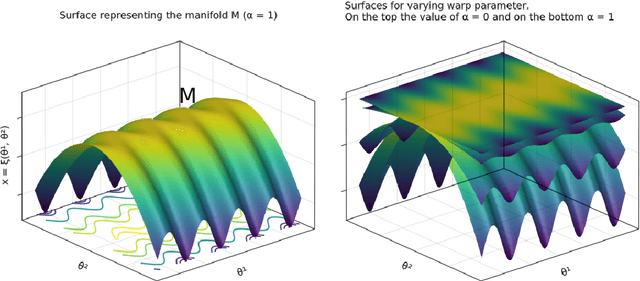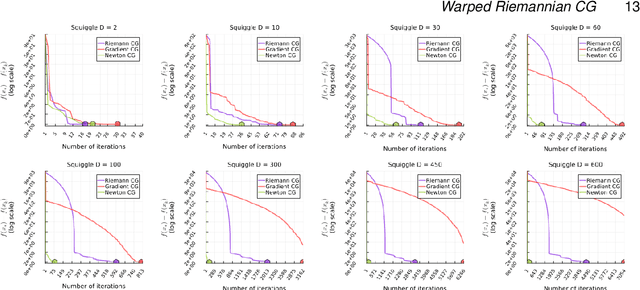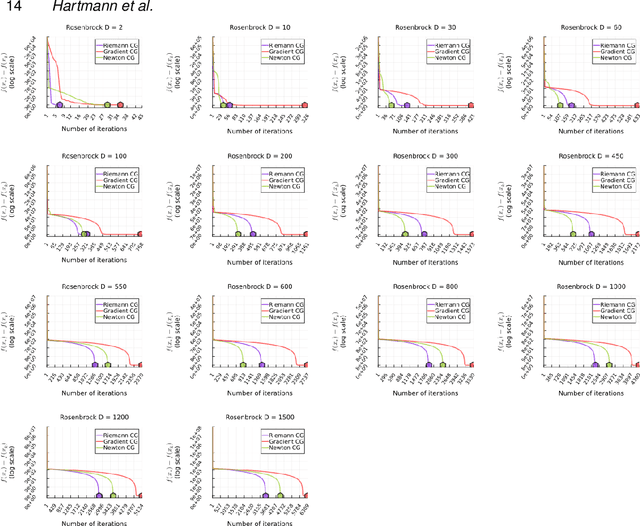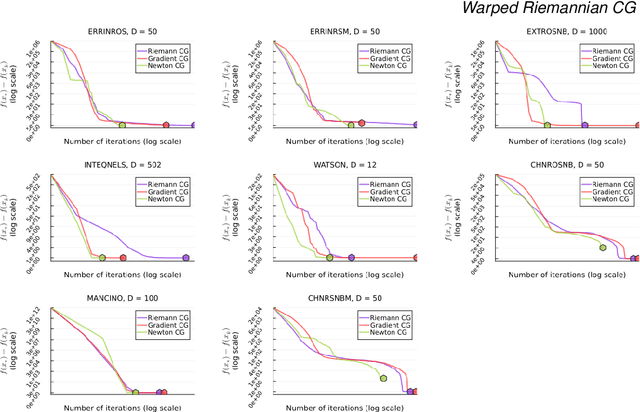Arto Klami
Simplex-to-Euclidean Bijections for Categorical Flow Matching
Oct 31, 2025Abstract:We propose a method for learning and sampling from probability distributions supported on the simplex. Our approach maps the open simplex to Euclidean space via smooth bijections, leveraging the Aitchison geometry to define the mappings, and supports modeling categorical data by a Dirichlet interpolation that dequantizes discrete observations into continuous ones. This enables density modeling in Euclidean space through the bijection while still allowing exact recovery of the original discrete distribution. Compared to previous methods that operate on the simplex using Riemannian geometry or custom noise processes, our approach works in Euclidean space while respecting the Aitchison geometry, and achieves competitive performance on both synthetic and real-world data sets.
On the Identifiability of Tensor Ranks via Prior Predictive Matching
Oct 16, 2025Abstract:Selecting the latent dimensions (ranks) in tensor factorization is a central challenge that often relies on heuristic methods. This paper introduces a rigorous approach to determine rank identifiability in probabilistic tensor models, based on prior predictive moment matching. We transform a set of moment matching conditions into a log-linear system of equations in terms of marginal moments, prior hyperparameters, and ranks; establishing an equivalence between rank identifiability and the solvability of such system. We apply this framework to four foundational tensor-models, demonstrating that the linear structure of the PARAFAC/CP model, the chain structure of the Tensor Train model, and the closed-loop structure of the Tensor Ring model yield solvable systems, making their ranks identifiable. In contrast, we prove that the symmetric topology of the Tucker model leads to an underdetermined system, rendering the ranks unidentifiable by this method. For the identifiable models, we derive explicit closed-form rank estimators based on the moments of observed data only. We empirically validate these estimators and evaluate the robustness of the proposal.
Learning geometry and topology via multi-chart flows
May 30, 2025Abstract:Real world data often lie on low-dimensional Riemannian manifolds embedded in high-dimensional spaces. This motivates learning degenerate normalizing flows that map between the ambient space and a low-dimensional latent space. However, if the manifold has a non-trivial topology, it can never be correctly learned using a single flow. Instead multiple flows must be `glued together'. In this paper, we first propose the general training scheme for learning such a collection of flows, and secondly we develop the first numerical algorithms for computing geodesics on such manifolds. Empirically, we demonstrate that this leads to highly significant improvements in topology estimation.
Geodesic Slice Sampler for Multimodal Distributions with Strong Curvature
Feb 28, 2025Abstract:Traditional Markov Chain Monte Carlo sampling methods often struggle with sharp curvatures, intricate geometries, and multimodal distributions. Slice sampling can resolve local exploration inefficiency issues and Riemannian geometries help with sharp curvatures. Recent extensions enable slice sampling on Riemannian manifolds, but they are restricted to cases where geodesics are available in closed form. We propose a method that generalizes Hit-and-Run slice sampling to more general geometries tailored to the target distribution, by approximating geodesics as solutions to differential equations. Our approach enables exploration of regions with strong curvature and rapid transitions between modes in multimodal distributions. We demonstrate the advantages of the approach over challenging sampling problems.
Density Ratio Estimation with Conditional Probability Paths
Feb 04, 2025Abstract:Density ratio estimation in high dimensions can be reframed as integrating a certain quantity, the time score, over probability paths which interpolate between the two densities. In practice, the time score has to be estimated based on samples from the two densities. However, existing methods for this problem remain computationally expensive and can yield inaccurate estimates. Inspired by recent advances in generative modeling, we introduce a novel framework for time score estimation, based on a conditioning variable. Choosing the conditioning variable judiciously enables a closed-form objective function. We demonstrate that, compared to previous approaches, our approach results in faster learning of the time score and competitive or better estimation accuracies of the density ratio on challenging tasks. Furthermore, we establish theoretical guarantees on the error of the estimated density ratio.
Preferential Normalizing Flows
Oct 11, 2024Abstract:Eliciting a high-dimensional probability distribution from an expert via noisy judgments is notoriously challenging, yet useful for many applications, such as prior elicitation and reward modeling. We introduce a method for eliciting the expert's belief density as a normalizing flow based solely on preferential questions such as comparing or ranking alternatives. This allows eliciting in principle arbitrarily flexible densities, but flow estimation is susceptible to the challenge of collapsing or diverging probability mass that makes it difficult in practice. We tackle this problem by introducing a novel functional prior for the flow, motivated by a decision-theoretic argument, and show empirically that the belief density can be inferred as the function-space maximum a posteriori estimate. We demonstrate our method by eliciting multivariate belief densities of simulated experts, including the prior belief of a general-purpose large language model over a real-world dataset.
Stochastic variance-reduced Gaussian variational inference on the Bures-Wasserstein manifold
Oct 03, 2024Abstract:Optimization in the Bures-Wasserstein space has been gaining popularity in the machine learning community since it draws connections between variational inference and Wasserstein gradient flows. The variational inference objective function of Kullback-Leibler divergence can be written as the sum of the negative entropy and the potential energy, making forward-backward Euler the method of choice. Notably, the backward step admits a closed-form solution in this case, facilitating the practicality of the scheme. However, the forward step is no longer exact since the Bures-Wasserstein gradient of the potential energy involves "intractable" expectations. Recent approaches propose using the Monte Carlo method -- in practice a single-sample estimator -- to approximate these terms, resulting in high variance and poor performance. We propose a novel variance-reduced estimator based on the principle of control variates. We theoretically show that this estimator has a smaller variance than the Monte-Carlo estimator in scenarios of interest. We also prove that variance reduction helps improve the optimization bounds of the current analysis. We demonstrate that the proposed estimator gains order-of-magnitude improvements over the previous Bures-Wasserstein methods.
Non-geodesically-convex optimization in the Wasserstein space
Jun 01, 2024Abstract:We study a class of optimization problems in the Wasserstein space (the space of probability measures) where the objective function is \emph{nonconvex} along generalized geodesics. When the regularization term is the negative entropy, the optimization problem becomes a sampling problem where it minimizes the Kullback-Leibler divergence between a probability measure (optimization variable) and a target probability measure whose logarithmic probability density is a nonconvex function. We derive multiple convergence insights for a novel {\em semi Forward-Backward Euler scheme} under several nonconvex (and possibly nonsmooth) regimes. Notably, the semi Forward-Backward Euler is just a slight modification of the Forward-Backward Euler whose convergence is -- to our knowledge -- still unknown in our very general non-geodesically-convex setting.
Riemannian Laplace Approximation with the Fisher Metric
Nov 08, 2023Abstract:The Laplace's method approximates a target density with a Gaussian distribution at its mode. It is computationally efficient and asymptotically exact for Bayesian inference due to the Bernstein-von Mises theorem, but for complex targets and finite-data posteriors it is often too crude an approximation. A recent generalization of the Laplace Approximation transforms the Gaussian approximation according to a chosen Riemannian geometry providing a richer approximation family, while still retaining computational efficiency. However, as shown here, its properties heavily depend on the chosen metric, indeed the metric adopted in previous work results in approximations that are overly narrow as well as being biased even at the limit of infinite data. We correct this shortcoming by developing the approximation family further, deriving two alternative variants that are exact at the limit of infinite data, extending the theoretical analysis of the method, and demonstrating practical improvements in a range of experiments.
Warped geometric information on the optimisation of Euclidean functions
Aug 16, 2023



Abstract:We consider the fundamental task of optimizing a real-valued function defined in a potentially high-dimensional Euclidean space, such as the loss function in many machine-learning tasks or the logarithm of the probability distribution in statistical inference. We use the warped Riemannian geometry notions to redefine the optimisation problem of a function on Euclidean space to a Riemannian manifold with a warped metric, and then find the function's optimum along this manifold. The warped metric chosen for the search domain induces a computational friendly metric-tensor for which optimal search directions associate with geodesic curves on the manifold becomes easier to compute. Performing optimization along geodesics is known to be generally infeasible, yet we show that in this specific manifold we can analytically derive Taylor approximations up to third-order. In general these approximations to the geodesic curve will not lie on the manifold, however we construct suitable retraction maps to pull them back onto the manifold. Therefore, we can efficiently optimize along the approximate geodesic curves. We cover the related theory, describe a practical optimization algorithm and empirically evaluate it on a collection of challenging optimisation benchmarks. Our proposed algorithm, using third-order approximation of geodesics, outperforms standard Euclidean gradient-based counterparts in term of number of iterations until convergence and an alternative method for Hessian-based optimisation routines.
 Add to Chrome
Add to Chrome Add to Firefox
Add to Firefox Add to Edge
Add to Edge